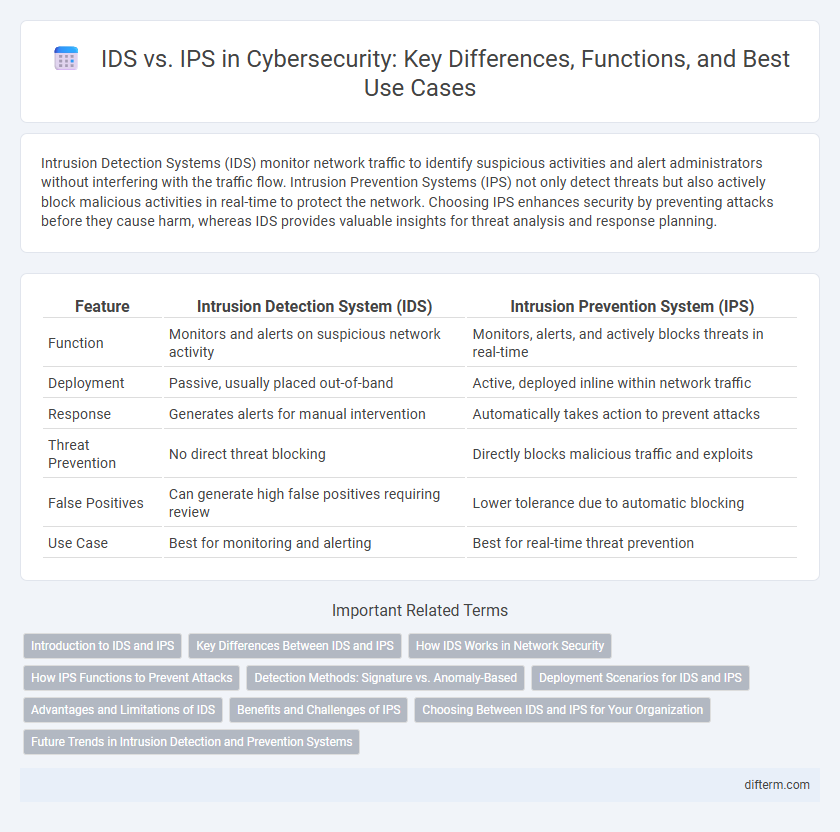Intrusion Detection Systems (IDS) monitor network traffic to identify suspicious activities and alert administrators without interfering with the traffic flow. Intrusion Prevention Systems (IPS) not only detect threats but also actively block malicious activities in real-time to protect the network. Choosing IPS enhances security by preventing attacks before they cause harm, whereas IDS provides valuable insights for threat analysis and response planning.
Table of Comparison
| Feature | Intrusion Detection System (IDS) | Intrusion Prevention System (IPS) |
|---|---|---|
| Function | Monitors and alerts on suspicious network activity | Monitors, alerts, and actively blocks threats in real-time |
| Deployment | Passive, usually placed out-of-band | Active, deployed inline within network traffic |
| Response | Generates alerts for manual intervention | Automatically takes action to prevent attacks |
| Threat Prevention | No direct threat blocking | Directly blocks malicious traffic and exploits |
| False Positives | Can generate high false positives requiring review | Lower tolerance due to automatic blocking |
| Use Case | Best for monitoring and alerting | Best for real-time threat prevention |
Introduction to IDS and IPS
Intrusion Detection Systems (IDS) monitor network traffic or system activities for malicious actions or policy violations, alerting administrators upon detection of threats. Intrusion Prevention Systems (IPS) extend IDS capabilities by actively blocking or preventing identified threats in real-time, enhancing network security posture. Both IDS and IPS are essential components in cybersecurity strategies, providing detection and prevention mechanisms to safeguard critical infrastructure from cyber attacks.
Key Differences Between IDS and IPS
Intrusion Detection Systems (IDS) primarily monitor network traffic for suspicious activity and generate alerts without taking direct action, whereas Intrusion Prevention Systems (IPS) actively block or prevent identified threats. IDS operates in a passive mode by analyzing and logging intrusion attempts, while IPS functions in-line with real-time traffic, enabling immediate response to cyber threats. The key distinction lies in IDS's detection and alert capability versus IPS's combined detection and prevention mechanisms within cybersecurity infrastructure.
How IDS Works in Network Security
Intrusion Detection Systems (IDS) monitor network traffic by analyzing data packets to identify suspicious activities or potential threats using signature-based or anomaly-based detection methods. IDS logs and alerts administrators in real-time when malicious behavior or policy violations are detected, enabling swift investigation. By providing continuous network visibility and forensic data, IDS supports proactive defense and incident response without interrupting normal network operations.
How IPS Functions to Prevent Attacks
Intrusion Prevention Systems (IPS) actively monitor network traffic to identify and block malicious activities in real time by analyzing packet content and behavior patterns. By employing signature-based detection, anomaly detection, and protocol analysis, IPS can detect known threats and zero-day exploits before they reach vulnerable systems. This proactive defense mechanism ensures immediate response to potential attacks, effectively preventing unauthorized access and data breaches.
Detection Methods: Signature vs. Anomaly-Based
Intrusion Detection Systems (IDS) primarily rely on signature-based detection, matching network traffic against a database of known attack patterns to identify threats quickly and accurately. Intrusion Prevention Systems (IPS) enhance this by incorporating anomaly-based detection, which monitors deviations from established behavioral baselines to identify zero-day attacks and unknown threats. Combining signature and anomaly-based methods increases threat detection efficiency and reduces false positives in cybersecurity defense.
Deployment Scenarios for IDS and IPS
Intrusion Detection Systems (IDS) are typically deployed in passive monitoring roles such as network perimeter scanning, where they analyze traffic without directly interfering with data flow, making them ideal for detecting suspicious activities and alerting administrators. Intrusion Prevention Systems (IPS), on the other hand, are positioned inline with network traffic, enabling real-time blocking of attacks by actively filtering and rejecting malicious packets, which is essential for environments requiring immediate threat mitigation. In high-security enterprise networks, IDS complements IPS by providing detailed forensic analysis and anomaly detection, while IPS maintains network integrity by preventing intrusions before they can impact critical systems.
Advantages and Limitations of IDS
Intrusion Detection Systems (IDS) excel in identifying and alerting on suspicious network or system activities without interfering with traffic, making them valuable for monitoring complex environments and detecting zero-day attacks. Their passive nature ensures minimal risk of disrupting legitimate operations, yet IDS cannot prevent attacks or block malicious traffic, relying heavily on timely human intervention for response. Limitations include high false positive rates and potential performance overhead, which can overwhelm security teams and delay incident handling.
Benefits and Challenges of IPS
Intrusion Prevention Systems (IPS) actively monitor network traffic to detect and block malicious activities in real-time, enhancing security by preventing attacks before they cause damage. The benefits of IPS include automated threat response, reduced false positives compared to traditional firewalls, and comprehensive protection against known and unknown vulnerabilities. Challenges involve potential network latency, the risk of false negatives allowing sophisticated threats to bypass detection, and the need for continuous updates and tuning to maintain effectiveness.
Choosing Between IDS and IPS for Your Organization
Choosing between Intrusion Detection Systems (IDS) and Intrusion Prevention Systems (IPS) depends on an organization's security posture and risk tolerance. IDS provides real-time monitoring and alerts for suspicious activities without blocking traffic, ideal for environments prioritizing network visibility and analysis. IPS extends IDS capabilities by automatically blocking detected threats, offering proactive defense but requiring carefully tuned rules to minimize false positives and avoid disrupting legitimate traffic.
Future Trends in Intrusion Detection and Prevention Systems
Future trends in intrusion detection and prevention systems (IDS and IPS) emphasize AI-driven threat intelligence integration to enhance real-time anomaly detection and response accuracy. Machine learning algorithms enable adaptive behavior analysis, reducing false positives and improving identification of zero-day exploits. Cloud-native IDS/IPS architectures are becoming standard, facilitating scalable protection across hybrid environments and leveraging automated updates for evolving cyber threats.
IDS vs IPS Infographic

 difterm.com
difterm.com